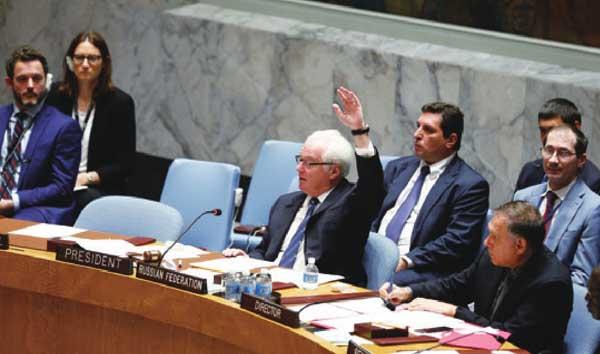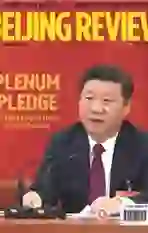Stuck in the Cold War
2016-05-14ByCliffordA.Kiracofe
By Clifford A. Kiracofe

The Obama administrations eight years in office have failed to reset U.S.-Russia relations. Instead, they have moved toward a provocative and volatile new Cold War scenario, thereby increasing world tensions. With President Barack Obama now a lame duck and the U.S. presidential election imminent, international concern over Washingtons future direction is understandable.
At home, the election campaign took a bizarre turn as Democrats accused Donald Trump, the Republican candidate, of being proRussia and then raised the specter of Russian President Vladimir Putin lurking behind the U.S. political scene. What is really behind this hysteria and Cold War mentality?
Despite sweeping changes in the international system since the fall of the Soviet Union in 1991, Washington has not been able to reset its own perspective and adjust to the emerging multipolar world. The old bipolar “us versus them” zero-sum thinking still drives U.S. foreign policy and outdated geopolitical strategies to contain the Eurasian landmass remain in place.
While Washington updates its rhetoric, the geopolitical policy fundamentals are unchanged. Todays containment, although called by new names such as “hedging,” “rebalancing,”and “pivoting,” parallels the old Cold War policy in terms of the military, diplomatic, economic, political, and psychological elements of power.
The level of nostalgia in Washington for the 19th century Great Game, which pitted the British Empire against the Russian Empire in Eurasia, seems to know no bounds. Since World War II, Americas foreign policy elite has imagined itself stepping into the former shoes of British imperialism to run the world as the supposedly “indispensable” nation.
Washingtons ideological confrontation continues in new forms. Russia no longer exports Marxism-Leninism, but the Obama administration has aggressively exported a“values agenda,” which includes the promotion of democracy and human rights as defined by Washington. This has led to chaos in the Middle East and North Africa.
The political and psychological elements of the old U.S. policy have simply been updated and repackaged for Obama. The United States has continued to promote a zero-sum bloc clash under the guise of “democracies versus non-democracies.”
Since 1991, Washington has sought to influence and alter Russias internal situation through various political and psychological means. Moscow, naturally, takes a dim view of activity which undermines state sovereignty, reading such efforts as an attempt to promote yet another “color revolution,” but this time in Russia itself.
The new Great Game
In the Obama years, Washingtons anti-Russia stance has been driven by a combination of old Cold War warriors, neoconservatives and human rights interventionists. Each of these policymaking groups, for its own reasons, promotes confrontation with Russia.
It seems forgotten today, but during the Bill Clinton years Washington engaged in some sharp-elbowed policies toward Russia. Geopolitics played a role in the U.S. oil and gas pipeline war against Russia and still does. Washington developed a new Great Game in central Asia directed at Russia.
Moscow has been concerned about diplomatic maneuvering and the use of U.S. force to contain Russia. Many Russian analysts see the increase of NATO member states as well as the global expansion of the NATO mission as a continuation of Cold War policy. As U.S. politicians called for the inclusion of Georgia and Ukraine in NATO, this perception was reinforced.
Then, the Obama administration, with aid behind the scenes from some Western European allies, launched the coup détat in the Ukraine. Washingtons provocations had reached a dangerous level indeed. Moscows logical response was to reincorporate Crimea and to take firm defensive measures along its western boundaries.
Obamas strategy in Central and Eastern Europe and confrontation with Russia were strongly influenced by the hawkish neoconservative policy network. Although neoconservatism, an American movement that advocates U.S. national interests and democracy internationally through the use of force if necessary, has been entrenched in the Democratic Party since the Truman years, it also has come to dominate Republican Party think-ing in recent decades.
U.S. moves to revive the Cold War in Europe are no surprise to observers familiar with neoconservative foreign policy. Although anti-Russia posturing is commonplace among neoconservatives, support for interference in the internal affairs of Central and Eastern European countries became active under the Obama administration.
The policy context, of course, was to confront Russia in areas of core interest in Central and Eastern Europe. In the case of Ukraine, the United States made no secret of spending over $5 billion during the past two decades to promote a color revolution and regime change. Hillary Clintons assistant Secretary of State for Europe and Eurasia, Victoria Nuland, publicly boasted about it in a speech in December 2013. Her husband, Robert Kagan, is a neoconservative policy network leader.
The Obama administration has used coercion in various forms in targeting Hungary and the Czech Republic. Hungary has been singled out for the outspoken leadership of President Viktor Orban and his Fidesz party. Washington objected to his independent foreign policy and to the development of economic and diplomatic relations perceived as too close to Russia and China. A particular sin was his support for the multinational South Stream pipeline project to bring natural gas from Russia to Central Europe.
Washingtons aggressive push for new ballistic missile defense systems in Europe and Asia has also reinforced Moscows perception of the hard power containment mentality of U.S. and NATO elites.
U.S. aggression in the Middle East was another trigger of Russian confrontation. The Syrian situation, which grew from the American destabilization of the Middle East and North Africa, is a case in point.
The American objective in Syria is regime change. To this end, Washington has directly and indirectly supported radical Islamist terror organizations who want to bring down the Assad government. This policy is being continued in the waning months of the Obama administration.
However, this reckless policy may have alarming consequences. In recent weeks, leading U.S. military figures publicly warned in Congress that an escalation of U.S. force in Syria to bring down the Assad government could lead to direct conflict between the United States and Russia. Although one hopes for restraint as the Obama administration fades into history, it is not guaranteed in the hysteria and delusion prevailing in Washington today.
So, where does this leave us?
Clearly, the United States and Russia have a huge interest in working together on a range of global issues. While mutual relations have fluctuated, both sides have usually found ways to cooperate. Even at the height of the Cold War, there was extensive diplomatic dialogue and fatal extremes were avoided.
Major power cooperation is essential to promote stability and development in this present era of rapid and far-reaching change. Pressing issues such as terrorism, organized crime, and nuclear proliferation demand attention. The trend of the times is the desire of the international community for peace and development.
The chill in U.S.-Russia relations may not be overcome soon if Obamas policies are continued by a Clinton administration. On the other hand, much to the ire of the U.S. foreign policy elites, Donald Trump has boldly stated that he would move to mend relations with Moscow.
Despite frosty U.S.-Russia relations today, both sides must strive for effective cooperation. Washington must leave the Cold War behind and face the future. It is urgent that the next U.S. president presses the reset button.
